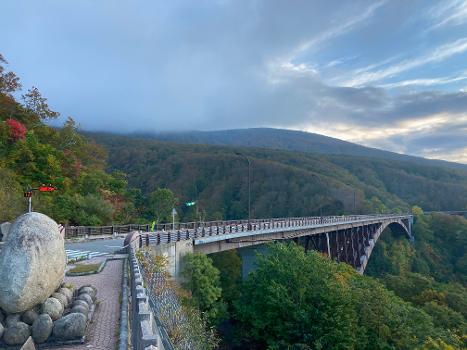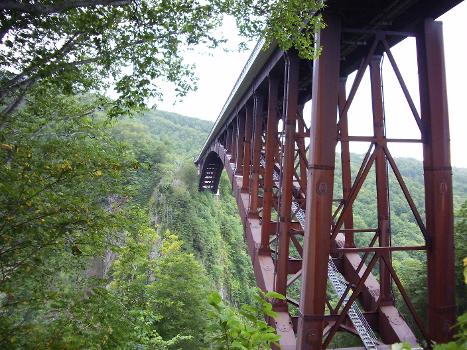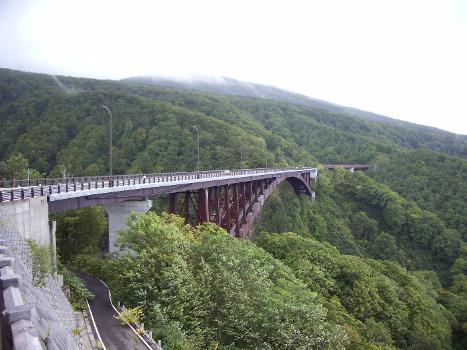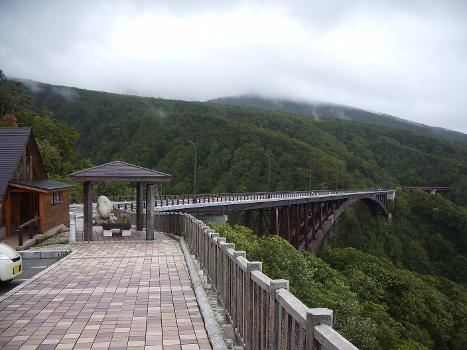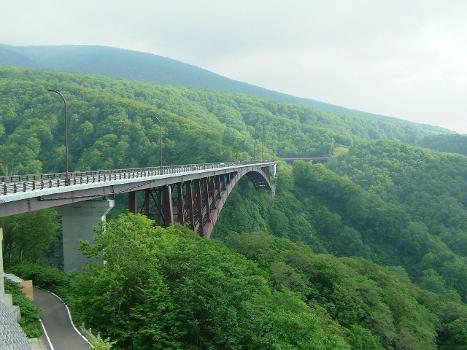General Information
| Name in local language: | 城ヶ倉大橋 (Jōgakura-ōhashi) |
|---|---|
| Completion: | 27 October 1995 |
| Status: | in use |
Project Type
| Structure: |
Deck arch bridge |
|---|---|
| Function / usage: |
Road bridge |
| Structure: |
Two-hinged arch bridge |
| Support conditions: |
for registered users |
| Material: |
Steel bridge |
| Plan view: |
Structurae Plus/Pro - Subscribe Now! |
| Material: |
Structurae Plus/Pro - Subscribe Now! |
Location
Technical Information
Dimensions
| main span | 255 m | |
| total length | 360 m | |
| height above valley floor or water | 122 m |
Materials
| deck |
steel
|
|---|---|
| piers |
reinforced concrete
|
| arches |
steel
|
| abutments |
reinforced concrete
|
| piers on arch |
steel
|
Excerpt from Wikipedia
Jōgakura Bridge (城ヶ倉大橋, Jōgakura-ōhashi) is a 360-meter-long (1,180 ft) deck arch bridge in the southern Hakkōda Mountains in the city of Aomori in Aomori Prefecture, Japan. It carries National Route 394 at a height of 122 meters (400 ft) above Jōgakura Creek. Located inside of Towada-Hachimantai National Park, the bridge is known as being a place for observing the area's scenic beauty as well as being the longest of ist type in Japan.
Description
The Jōgakura Bridge is a 360-meter-long (1,180 ft) and 11.5-meter-wide (38 ft) deck arch bridge that carries National Route 394 at a height of 122 meters (400 ft) above Jōgakura Creek. The bridge's main span has a length of 255 meters (837 ft). It is equipped with two meter-wide sidewalks on each side of the bridge. It is the longest deck arch bridge in Japan. The bridge is known as tourist destination because the panoramic views it affords of the Hakkōda Mountains in Towada-Hachimantai National Park. The Jōgakura Bridge becomes especially crowded with tourists when the surrounding Siebold's beech forests begin to change color during autumn.
History
Jōgakura Bridge was opened to traffic on 27 October 1995, replacing an older bridge that was heavily impacted by the rapid deterioration of the columnar jointed andesite rock that it was built on. The total cost of ist construction was 87 billion yen.
Suicides
The bridge's height makes it a target for jumpers. In the event of someone jumping from the bridge, the approaches to the bridge are closed to traffic while helicopter teams attempt to recover the jumper from the valley below. Some blame paranormal activity for the suicides, claiming that the bridge and ist surroundings are haunted by the spirits of the troops that died in the Hakkōda Mountains incident and that they pull or compel visitors off the bridge, usually at night.
Text imported from Wikipedia article "Jōgakura Bridge" and modified on September 27, 2021 according to the CC-BY-SA 4.0 International license.
Participants
Currently there is no information available about persons or companies having participated in this project.
Relevant Web Sites
- About this
data sheet - Structure-ID
20052385 - Published on:
25/01/2010 - Last updated on:
26/12/2021


